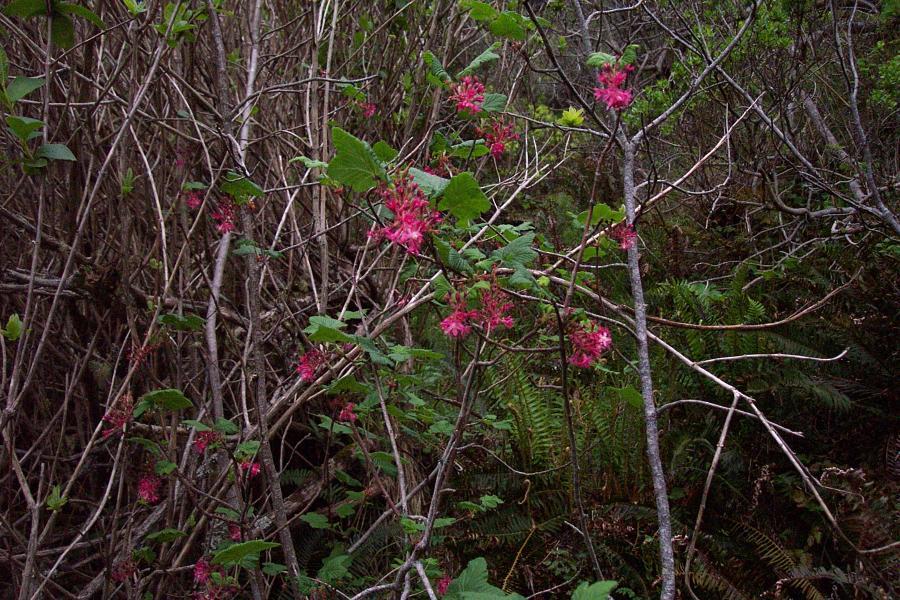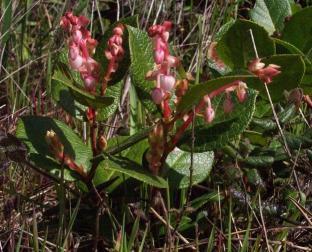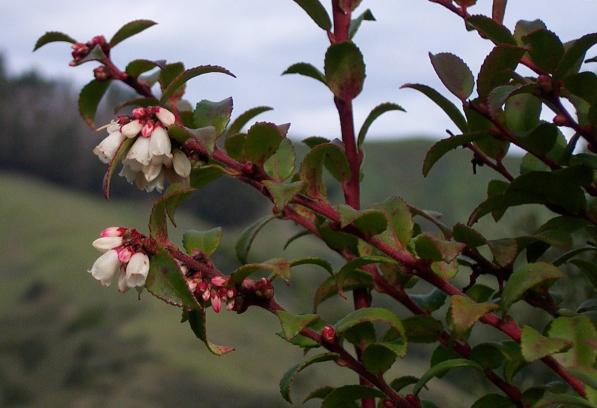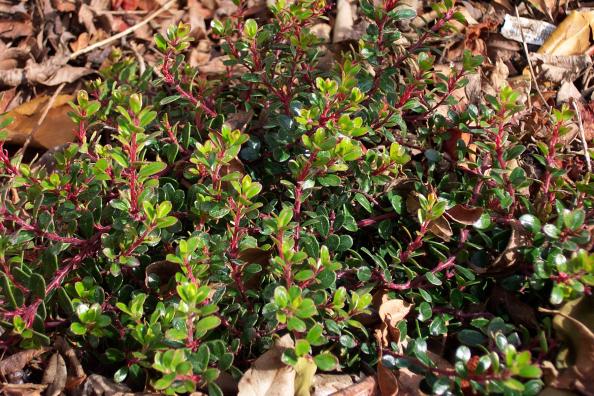
|
Generated by CNPLX;
checklist last changed on 06/04/2003 08:48
|

|
|
Note:
The following is a substantial excerpt from a brochure
available in the parking lot of Jughandle State Reserve
just off Highway 1, directly north of Caspar, Mendocino County.
The brochure is printed by the State of California and
distributed by Califormia State Parks. The text quoted here
is © 1998 by Teresa Sholars.
The purpose of re-presenting part of the brochure here is
to demonstrate the checklist and report capabilities of CNPLX.
This HTML document was generated by CNPLX from a checklist.
|
|
Jughandle State Reserve Ecological Staircase Trail
|
|
You are standing on one of the most interesting geological
areas in the northern hemisphere.
Here, time, geological forces and climate have all interacted
to form a staircase of distinct plant communities and associated soils,
culminating in the unique Pygmy Forest.
The numbers in this brochure correspond to numbered posts that you
will find along the trail. The trail is about 2.5 miles long
and takes approximately 3 hours to complete.
|
|
Picea sitchensis
|
Sitka spruce
|
(Tree)
|
|
|
|

Charles Webber © 2000 California Academy of Sciences
(CalPhotos)
|
| |
|
Abies grandis
|
grand fir
|
(Tree)
|
|
6. This oddly shaped Grand fir is lying on its side, its upright branches
killed by the drying effect of salt-laden winds. Growing to about 200', its thin bark is often covered with patches of white
crustose lichens and sap pockets. The needle tips are shaped in an
'm', with two white stomatal lines on the back of each needle.
All true firs have erect deciduous cones, shattering on the tree, spreading their seeds in the winds. Thus mature cones are seldom seen on the ground. Occasionally immature cones partially eaten by a Gray or
Douglas squirrel may be seen along the trail. Seedlings germinate
well in shady sites. The heartwood and sapwood is white and like
the foliage is quite aromatic. These trees are common near the
coast, where they tolerate the salty winds, but more rare inland to about
10 miles. They grow from northern Sonoma Co to southern British Columbia
eastward to Montana and Idaho. The wood is used for general construction and pulpwood. They live up to 200 years.
Elevation 0 - 2296 feet
|

Brother Alfred Brousseau © 1995 Saint Mary's College of California
(CalPhotos)
|
| |
|
Calamagrostis nutkaensis
|
Pacific reedgrass
|
(Perennial herb)
|
|
|
|

© 2001 Tom Annese
(CalPhotos)
|
| |
|
Ribes sanguineum var. glutinosum
|
Flowering Currant
|
(Shrub)
|
|
8. This deciduous shrub has pink flowers in the spring
and purple currants in the fall that provide food for wildlife.
The alternate leaves are veined and lobed like a maple leaf.
Its flowers and leaves have a distinctive smell.
This species is often used in ornamental landscapes and occurs in
riparian moist sites from Washington to
central California.
Elevation 0 - 3281 feet
|

coastal scrub, Navarro bluff (c) 2002 J Malpas
|
| |
|
Pinus muricata
|
Bishop pine
|
(Tree)
|
|
9. You are standing in a forest type that
is not common in California, the North Coast Bishop Pine Forest.
Unlike most conifers, Bishop pine does not open its cones
and distribute its seeds when they are mature.
They release their seeds only when the cones are exposed to intense heat.
This adaptation to fire discharges seeds into a bed of fertile ash.
Bishop pine grows to less than 100' and is fairly short lived
to approximately 80 years. It grows on sandy soils here on the
first terrace near the ocean, on old dunes in patches in the
Redwood Forests and in older soils in the Pygmy Forest.
It ranges from coastal northern Baja to Humboldt Co.
The mature trees are round headed instead of the typical cone
shape of most conifers.
Elevation 0 - 984 feet
|

Brother Alfred Brousseau © 1995 Saint Mary's College of California
(CalPhotos)
|
| |
|
Rhamnus purshiana
|
cascara sagrada
|
(Tree, Shrub)
|
|
|
|

Brother Alfred Brousseau © 1995 Saint Mary's College of California
(CalPhotos)
|
| |
|
Salix lucida ssp. lasiandra
|
Pacific willow
|
(Tree)
|
|
|
|

Charles Webber © 1999 California Academy of Sciences
(CalPhotos)
|
| |
|
Alnus rubra
|
Oregon Alder
|
(Tree, Shrub)
|
|
|
|

Brother Alfred Brousseau © 1995 Saint Mary's College of California
(CalPhotos)
|
| |
|
Sambucus racemosa
|
red elderberry
|
(Shrub)
|
|
|
|

Charles Webber © 1999 California Academy of Sciences
(CalPhotos)
|
| |
|
Myrica californica
|
California Wax-myrtle
|
(Shrub)
|
|
|
|

Brother Alfred Brousseau © 1995 Saint Mary's College of California
(CalPhotos)
|
| |
|
Pinus radiata
|
Monterey pine
|
(Tree)
|
|
17. Look and see if you can tell the difference between the greener
3-needled Monterey pine and the native 2-needled Bishop pine.
The Monterey pines were planted here by early landowners
but are native only to the Monterey peninsula.
Rarity 3
|

Brother Alfred Brousseau © 1995 Saint Mary's College of California
(CalPhotos)
|
| |
|
Pseudotsuga menziesii var. menziesii
|
Douglas-fir
|
(Tree)
|
|
|
|

Charles Webber © 1998 California Academy of Sciences
(CalPhotos)
|
| |
|
Arctostaphylos columbiana
|
hairy manzanita
|
(Tree, Shrub)
|
|
21. Feel the bark on this manzanita. Last year's bark is sparse
and peeling away. This year's bark is red, hard, and smooth.
Hairy manzanita can grow as a shrub or small tree depending on light
availability. It has white flowers, blooming in January and February
when there are few other flowers in bloom, providing a source of
food for bumblebees. It is similar to one of its relatives, the madrone tree,
which has orange peeling bark and larger leaves.
Madrones are rare this close to the coast.
Manzanita berries are mealy but edible.
Hairy manzanita grows in coniferous forest along the coast from sea
level to 2,500' from northern California to British Columbia.
Elevation 0 - 2624 feet
|

Brother Alfred Brousseau © 1995 Saint Mary's College of California
(CalPhotos)
|
| |
|
Rhododendron macrophyllum
|
California rose-bay
|
(Shrub)
|
|
22. There are over 100 species of rhododendron in the north temperate
region and Austrailia. The leaves are poisonous to livestock.
This species is an evergreen shrub or small tree with beautiful pink flowers
and leaves that cluster at the ends of branches.
It grows in acidic soils in moist coniferous forest
in coastal mountains from San Francisco to British Columbia.
Elevation 0 - 3609 feet
|

Brother Alfred Brousseau © 1995 Saint Mary's College of California
(CalPhotos)
|
| |
|
Lithocarpus densiflorus
|
Tanbark Oak
|
(Tree, Shrub)
|
|
|
|

Beatrice F. Howitt © 1999 California Academy of Sciences
(CalPhotos)
|
| |
|
Sequoia sempervirens
|
coast redwood
|
(Tree)
|
|
24. Now that we are away from the salt laden breezes of the ocean
the forest changes and is now dominated by redwoods. Redwoods have a limited
distribution, occurring only along the coast between southern
Oregon and central California where summer fog and moderate temperatures
prevail.
The bark is thick, red, fibrous and fire resistant.
Look on the ground and you can see that the needles fall in
branchlets instead on singly like in other conifers.
The heartwood is red, and the sapwood is pink. The small oval cone is
about 1 inch in diameter with its scales touching like in a
soccer ball instead of overlapping like in the cones of pines, firs, and spruces.
The heartwood, especially in old growth, is rot resistant.
The timber is highly valued for use as siding, paneling, fencing,
decking, garden landscaping and building foundations.
This tree can live to about 2,000 years. It is one of the only
conifers that stump sprouts, forming rings of new trees
after one is cut. The tallest redwood is 368' tall and 12'6" in diameter.
Elevation 0 - 3608 feet
|

Walter Knight © 1999 California Academy of Sciences
(CalPhotos)
|
| |
|
Veratrum fimbriatum
|
Fringed cornlily
|
(Perennial herb)
|
|
|
|

Rick York © 2002 California Native Plant Society
(CalPhotos)
|
| |
|
Vaccinium parvifolium
|
California red huckleberry
|
(Shrub)
|
|
|
|

Brother Alfred Brousseau © 1995 Saint Mary's College of California
(CalPhotos)
|
| |
|
Tsuga heterophylla
|
western hemlock
|
(Tree)
|
|
|
|

Charles Webber © 1998 California Academy of Sciences
(CalPhotos)
|
| |
|
Gaultheria shallon
|
salal
|
(Shrub)
|
|
|
|

1 mi S of Mendocino 6/2002 (c) 2002 J Malpas
|
| |
|
Vaccinium ovatum
|
California huckleberry
|
(Shrub)
|
|
31.
Elevation 9 - 2624 feet
|

Huckleberry canyon, Oakland 2/2003 (c) J Malpas 2003
|
| |
|
Pinus contorta ssp. bolanderi
|
Bolander pine
|
(Tree)
|
|
|
|

Rick York © 1986 California Native Plant Society
(CalPhotos)
|
| |
|
Cupressus goveniana ssp. pigmaea
|
pygmy cypress
|
(Tree)
|
|
|
|

Charles Webber © 1998 California Academy of Sciences
(CalPhotos)
|
| |
|
Ledum glandulosum
|
western Labrador tea
|
(Shrub)
|
|
|
|

Brother Alfred Brousseau © 1995 Saint Mary's College of California
(CalPhotos)
|
| |
|
Arctostaphylos nummularia
|
Shatterberry
|
(Shrub)
|
|
37. This low growing manzanita grows most abundantly in the Pygmy Forest
but ranges as far south as San Francisco on poor soils.
It has small dark green leaves and red peeling bark.
Pink urn shaped flowers produce small apple-like
fruit in the fall.
Elevation 0 - 1968 feet
|

(c) 2003 J Malpas
|
| |
























